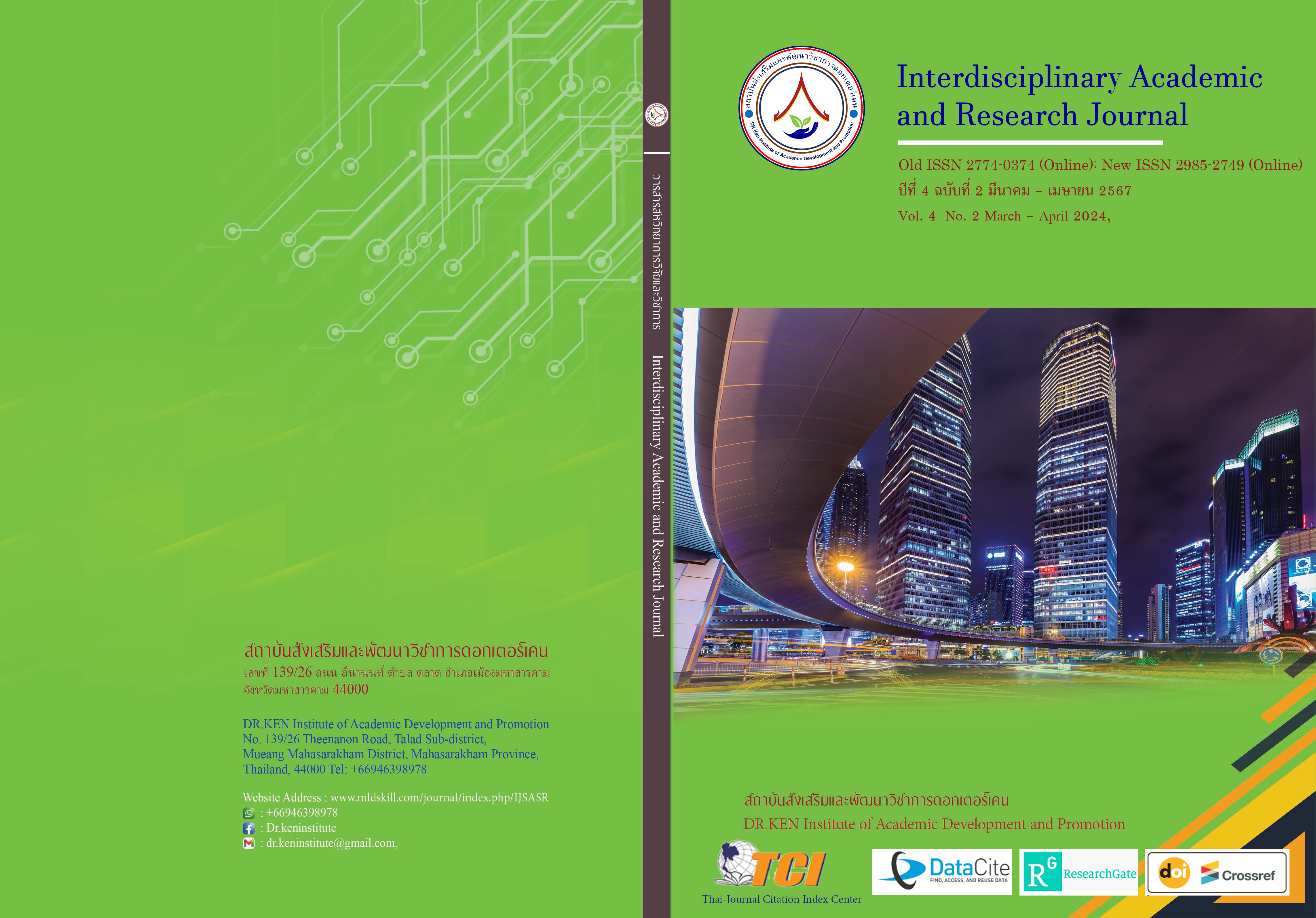The Development of Happy Organization Indicators of Private Vocational Colleges in The Northeast
DOI:
https://doi.org/10.60027/iarj.2024.274838Keywords:
Development of indicators;, Happy organization; , Private Vocational Colleges; , NortheastAbstract
Background and Aims: The concept of a happiness organization is another idea aimed at promoting the quality of life in the workplace for individuals. It believes that fostering relationships within the organization leads to happiness. The feeling of being valued and having a sense of worth to the organization creates a sense of commitment, joy, love in work, and devotion to the organization. ready to dedicate physical and mental strength to contribute fullest potential of the organization. This research aims, to development of happy organization indicators and to test the goodness of fit of the structural relationship model of happy organization indicators of private vocational colleges in the Northeast with empirical data.
Methodology: The research is divided into 2 phases. Phases 1 to development of happy organization indicators. The key informants group consisted of 9 experts, a sample group of 490 administrators and teachers. The research instrument is an interview form and a questionnaire. Statistics to analyze data by mean and standard deviation. Phase 2 to test the goodness of fit of the structural relationship model happy organization indicators of private vocational colleges in the Northeast with the empirical data, by second-order confirmatory factor analysis.
Results: The indicators of the happy organization of private vocational colleges in the Northeast comprised 5 factors and 25 indicators, Happy people 5 indicators, Happy home 5 indicators, Organizational culture 5 indicators, Job satisfaction 5 indicators, and Happy Teamwork 5 indicators. 2. The goodness of fit of the structural relationship model of happy organization indicators of private vocational colleges in the Northeast. It was in good agreement with the empirical data, with Chi-Square = 3853.531, df = 270, P-Value = 0.000, CMIN/df. = 1.428, CFI = .962, GFI = 0.929 TLI = .958, AGFI= 0.915, RMSEA=0.033 RMR= 0.030, NFI= 0.886, IFI= 0.963. Every component had a statistically significant relationship at the 0.001 level.
Conclusion: The consideration of workplace happiness is deemed a crucial factor in organizational management, particularly in the realm of human resource management. It has a significant impact on an individual level, fostering greater motivation and effectiveness in the workplace, and creating an atmosphere of happiness in the educational environment, administrators, teachers, and students collaboratively work together with full dedication and ability, resulting in improved operations and increased efficiency and effectiveness. Creating a positive image for the organization, and most importantly, the ultimate product of the educational institution: students who receive instruction from teachers working joyfully
References
กอปรลาภ อภัยภักดิ์. (2563). บรรยากาศองค์กรแห่งความสุข: คนเบิกบาน งานสำเร็จ. วารสาร มจร. มนุษยศาสตร์ปริทรรศน์, 6(1), 315-331
จุฑามาศ แก้วพิจิตร และวิชัย อุตสาหกิจ. (2556). สู่การเป็นองค์การแห่งความสุข. นนทบุรี: สองขาครีเอชั่น.
ทิพวัลย์ รามรง. (2557). สารสาระองค์กรแห่งความสุข เล่ม 1. กรุงเทพฯ : พี.เอ. ลีฟวิ่ง.
บุรินทร์ เทพสารและอภิภา ปรัชญพฤทธิ์. (2560). ยุทธศาสตร์การบริหารการเปลี่ยนแปลงสถาบันอุดมศึกษาเอกชนสู่การเป็นองค์กรแห่งความสุข. Journal of Education Studies, 45(3), 83–96. Retrieved from https://so02.tci-thaijo.org/index.php/EDUCU/article/view/107391
พงศกร ศรีรงค์ทอง. (2022). องค์การแห่งความสุข: มุมมองจากอาจารย์มหาวิทยาลัย. วารสารสุทธิปริทัศน์ 36 (2), 151-169. Bangkok, Thailand:150-69. https://so05.tci-thaijo.org/index.php/DPUSuthiparithatJournal/article/view/257899
รุ่งนภา ชุณหวรชัย. (2556). แนวทางการพัฒนาองค์กรแห่งความสุข “คึกฤทธิ์ อาร์คิเทค”. การศึกษาค้นคว้าอิสระ บริหารธุรกิจมหาบัณฑิต สาขาวิชาการปกครองท้องถิ่น: มหาวิทยาลัยขอนแก่น.
วรรณภา ลือกิตินันท์. (2557). แนวทางการสร้างองค์กรสุขภาวะในบริษัทข้ามชาติ : กรณีศึกษาบริษัทอุตสาหกรรมการผลิต ในภาคตะวันออก. Journal of Management Sciences. 31(1), 1-15.
สมคิด ปิ่นทอง. (2556) รูปแบบการจัดการการกีฬาแห่งประเทศไทยให้เป็นองค์กรแห่งความสุข . กรุงเทพฯ: มหาวิทยาลัยเกษตรศาสตร์.
สังข์ทอง รอญศึก. (2556). การพัฒนารูปแบบประสิทธิผลของการทำงานเป็นทีมในสถานศึกษา สังกัดสำนักงานคณะกรรมการการศึกษาขั้นพื้นฐานในภาคตะวันออกเฉียงเหนือ. วิทยานิพนธ์ปรัชญาดุษฎีบัณฑิต: มหาวิทยาลัยราชภัฏสกลนคร
สำนักงานกองทุนสนับสนุนการสร้างเสริมสุขภาพ (สสส.). (2556). มาสร้างองค์กรแห่งความสุขกันเถอะ. กรุงเทพฯ : สำนักงานกองทุนสนับสนุนการสร้างเสริมสุขภาพ.
สำนักงานกองทุนสนับสนุนการสร้างเสริมสุขภาพ (สสส.). (2557). 10 วิธีสร้างความสุขในที่ทำงานด้วยตัวคุณเอง. Retrieved from: https://www.thaihealth.or.th/Content/
สำนักงานปลัดกระทรวงศึกษาธิการ. (2563). แผนสร้างความผูกพันและความพึงพอใจในบุคลากรในสังกัดสำนักงานปลัดกระทรวงศึกษาธิการ. Retrieved from: http://www.bga.moe.go.th/2018/wp-content/uploads/2020/05/.
สำนักสนับสนุนสุขภาวะองค์กร. (2552). หนังสือความสุข 8 ประการ Happy 8. กรุงเทพฯ : สำนักงานกองทุนสนับสนุนการสร้างเสริมสุขภาพ (สสส.).
อธิคุณ สินธนาปัญญา และคณะ. (2557). การบริหารความสุขในสถานศึกษา. วารสารสุทธิปริทัศน์, 28(88), 15-32.
อภิชัย พันธเสน. (2555). การบริหารองค์กรเพื่อความสุขและประโยชน์สุข. วารสารบริหารศาสตร์ มหาวิทยาลัยอุบลราชธานี. 1(1),1-5.
Burton, J. (2010). WHO healthy workplace framework and model: Background and supporting literature and practices. Switzerland: World Health Organization. Retrieved from http://www.who.int/
World Health Organization (2010). Global Recommendations on Physical Activity for Health. World Health Organization, Geneva.
Downloads
Published
How to Cite
Issue
Section
License
Copyright (c) 2024 Interdisciplinary Academic and Research Journal

This work is licensed under a Creative Commons Attribution-NonCommercial-NoDerivatives 4.0 International License.
Copyright on any article in the Interdisciplinary Academic and Research Journal is retained by the author(s) under the under the Creative Commons Attribution-NonCommercial-NoDerivatives 4.0 International License. Permission to use text, content, images, etc. of publication. Any user to read, download, copy, distribute, print, search, or link to the full texts of articles, crawl them for indexing, pass them as data to software, or use them for any other lawful purpose. But do not use it for commercial use or with the intent to benefit any business.
















.png)


